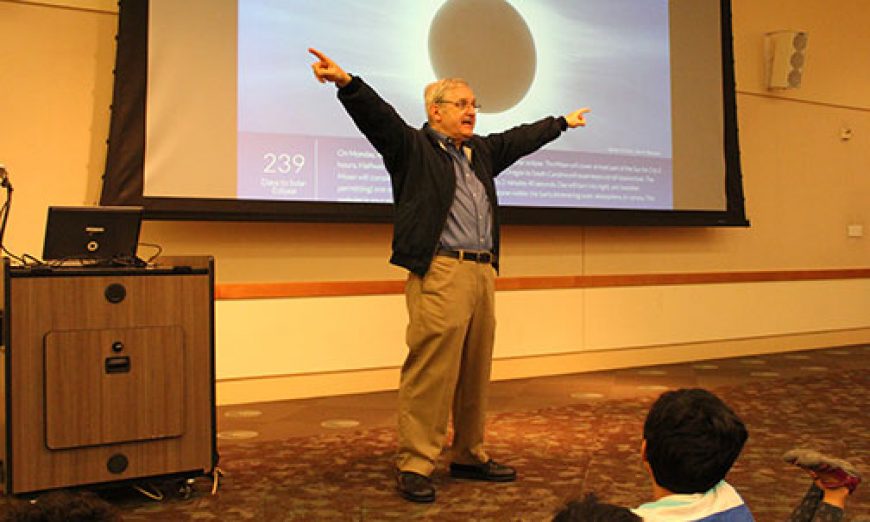Once upon a time, people believed a dragon or a monster was gobbling up the sun when the sky darkened during an eclipse. So people would “frighten the monster” by screaming and banging pots and pans together. Although this ritual seemed to end the eclipse, the cause of the eclipse obviously had nothing to do with creatures eating the sun. Astronomer and Foothill College Professor Andrew Fraknoi explained this and more about eclipses, including the upcoming Aug. 21 eclipse, at his well-attended July 29 lecture at Central Park Library called “The Sky Event of the Decade: August’s ‘All-American’ Eclipse of the Sun and How to View it Safely.”
“There’s going to be for the first time in 99 years an eclipse of the sun that crosses the United States,” said Fraknoi, co-author of a children’s book called “When the Sun Goes Dark.” “And in fact the total eclipse of the sun is going to be visible from one country, and one country only, and that’s the U.S. They’re already calling it the All-American Eclipse. I’m sure the administration in Washington is going to take full credit for it.”
Fraknoi explained that during an eclipse, the moon gets in front of the sun.
“The sun and the moon line up exactly and as a result, the shadow of the moon makes a dark spot on Planet Earth.” Fraknoi said. “If you are in that dark spot when the moon gets in front of the sun, daylight becomes night. The stars come out. It’s an eerie and magnificent experience.”
On Aug. 21, a total eclipse will be viewable in some areas outside of California. Fraknoi explained that those in the Bay Area can view a partial eclipse that day beginning at 9 a.m.
“The sun will be eclipsed to its maximum at 10:15 a.m.—76 percent of the sun will be covered at 10:15 a.m.—and it will all be over by around 11:30 a.m.,” said Fraknoi of viewing the August eclipse in the Bay Area. “If you’re going to be out that morning looking at the eclipse, you’re going to be standing under the sun for a long time. Please bring with you all the things you’d bring if you spend a couple of hours on the beach on a Monday morning. You would never go out into the sun on the beach without a nice hat, without sunscreen, without bottles of water.”
While Fraknoi noted that eclipses are best viewed in areas where the weather is clear, he also warned against looking at the sun without appropriate eye protection (do not view an eclipse with sunglasses).
“At the end of the lecture, you’re getting a special set of glasses, which although the paper frame doesn’t look like anything special, the lenses—what’s in the glasses—is made of a special plastic that cuts out the vast majority of sunlight and makes it perfectly safe to look at the sun,” he said. “So you’ll all be prepared for the eclipse.”
Stephanie Welch, an attendee of the lecture, enjoyed Fraknoi’s lecture and appreciated the complimentary eclipse viewing shades distributed by the Santa Clara City Library.
“When I looked through the shades into the sun, it looked like an orange harvest moon,” said Welch. “On Aug. 21, we’re driving to Lincoln, Nebraska to see the full eclipse at a cornfield.”
“Andrew Fraknoi was instrumental in working with this organization called StarNet,” said Rachel Schmidt, the library’s program coordinator for adult services. “StarNet is aimed at schools and libraries to give out these solar eclipse viewing glasses and to do programs to get people excited about this eclipse.”
Schmidt added that the Central Park Library will host an eclipse viewing party on Aug. 21. More details about this event can be found at santaclaraca.gov/government/departments/library/events. Visit bit.ly/2bkGSvA for Fraknoi and Dennis Schatz’s booklet that provides additional details about the Aug. 21 eclipse, including where to purchase shades.






